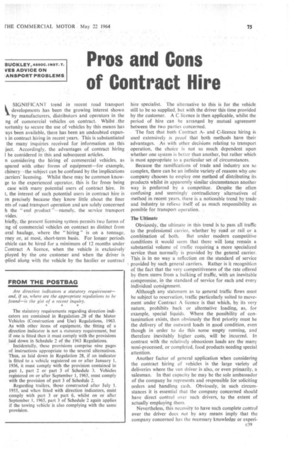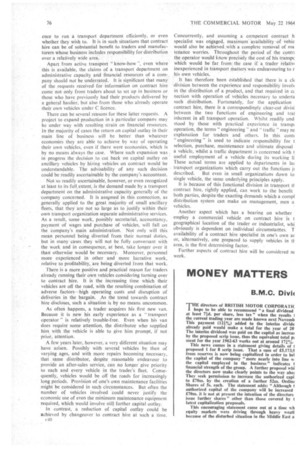Pros and Cons of Contract Hire
Page 77

Page 78

If you've noticed an error in this article please click here to report it so we can fix it.
SIGNIFICANT trend in recent road transport developments has been the growing interest shown
by manufacturers, distributors and operators in the ng of commercial vehicles on contract. Whilst .the )ortunity to secure the use of vehicles by this means has rays been available, there has been an undoubted expann in contract hiring in recent years. This is substantiated the many inquiries received for information on this ,ject Accordingly. the advantages of contract hiring be considered in this and subsequent articles.
n considering the hiring of commercial vehicles, as npared with other forms of eauipment—for example, chinery—the subject can be confused by the implications carriers' licensing. Whilst these may be common knowge to the experienced operator, this is far from being case with many potential users of contract hire. In t, the interest of such potential users in contract hire is en precisely because they know little about the finer nts of road transport operation and are solely concerned h the end product "—namely, the service transport 'vides.
3riefly, the present licensing system permits two forms of ing of commercial vehicles on contract as distinct from ieraI haulage, where the " hiring " is on a tonnage, rney or, at most, short-term basis. For longer periods chicle can be hired for a minimum of 12 months under Contract A licence, when the vehicle is exclusively ployed by the one customer and when the driver is plied along with the vehicle by the haulier or contract
hire specialist. The alternative to this is for the vehicle still to be so supplied, but with the driver this time provided by the customer. A C licence is then applicable, whilst the period of hire can be arranged by mutual agreement between the two parties concerned.
• The fact that both Contract Aand C-licence hiring is used extensively is proof that both methods have their advantages. As with other decisions relating to transport operation, the choice is not so much dependent upon whether one system is better than another, but rather which is most appropriate to a particular set of circumstances.
Because the ramifications of trade and industry are so complex, there can be an infinite variety of reasons why one company chooses to employ one method of distributing its products whilst in apparently similar circumstances another way is preferred by a competitor. Despite the often confusing and seemingly contradictory alternatives of method in recent years, there is a noticeable trend by trade . and industry to relieve itself of as much responsibility as possible for transport operation. .
The Ultimate ' Obviously, the ultimate in this trend is to pass all traffic to the professional carrier, whether by road or rail or a combination of both. But under modern competitive Conditions it would seem that there will long remain a substantial volume of traffic requiring a more specialized service than normally is provided by the general carrier. This is in no way a reflection on the standard of service
• provided by such general carriers. Rather is it recognition
of the fact that the very competitiveness of the rate offered by them stems from a bulking of traffic, with an inevitable compromise, in the standard of service for each and every individual consignment.
Although any statement as to general traffic flows must be subject to reservation, traffic particularly suited to movement under Contract A licence is that which, by its very nature, prohibits back or alternative loading, as, for example, special liquids. Where the possibility of contamination exists, then obviously the first priority must be the delivery of the outward loads in good condition, even though in order to do this some empty running, and therefore inevitably higher costs, will be incurred. In contrast with the relatively obnoxious loads are the many semi-processed, or completed, food products needing special attention.
Another factor of general application when considering
the contract hiring of vehicles is the large variety of deliveries where the van driver is also, or even primarily, a salesman. In that capacity he may be the sole ambassador of the company he represents and responsible for soliciting orders and handling cash. Obviously, in such circumstances it is essential that the company concerned should have direct control over such drivers, to the extent of actually employing them.
Nevertheless, this necessity to have such complete control over the driver does not by any means imply that the company concerned has the necessary knowledge or experic39 ence to run a transport department efficiently, or even whether they wish to. It is in such situations that contract hire can be of substantial benefit to traders and manufacturers whose business includes responsibility for distribution over a relatively wide area.
Apart from active transport "know-how ", even where this is available, the claims of a transport department on administrative capacity and financial resources of a company should not be underrated. It is significant that many of the requests received for information on contract hire come not only from traders about to set up in business or those who have previously had their products delivered by a general haulier, but also from those who already operate their own vehicles under C licence.
There can be several reasons for these latter requests. A project to expand production in a particular company may be under way with resulting strain on financial resources. In the majority of cases the return on capital outlay in their main line of business will be better than whatever economies they arc able to achieve by way of operating their own vehicles, even if there were economies, which is by no means always the case. Where such expansion was in progress the decision to cut back on capital outlay on ancillary vehicles by hiring vehicles on contract would be understandable. The advisability of any such decision could be readily ascertainable by the company's accountant.
Not so readily ascertainable, however, or even recognized at least to its full extent, is the demand made by a transport department on the administrative capacity generally of the company concerned. It is assymed in this connection, as generally applied to the great majority of small ancillary fleets, that they are not so large as to justify within their own transport organization separate administrative services. As a result, some work, possibly secretarial, accountancy, payment of wages and purchase of vehicles, will fall on the company's main administration. Not only will this mean personnel being diverted from their normal duties, but in many -cases they will not be fully conversant with the work and in consequence, at best, take longer over it than otherwise would be necessary. Moreover, personnel more experienced in other and more lucrative work, relative to profitability, are being diverted from that work.
There is a more positive and practical reason for traders already running their own vehicles considering turning over to contract hire. It is the increasing time which their vehicles are off the road, with the resulting combination of adverse factors—high operating costs and disruption of deliveries in the bargain. As the trend towards contract hire discloses, such a situation is by no means uncommon.
As often happens, a trader acquires his first new van. Because it is new his early experience as a transport operator is relatively trouble-free. Even when his van does require some attention, the distributor who supplied him with the vehicle is able to give him prompt, if not prior, attention.
A few years later, however, a very different situation may have arisen. Possibly with several vehicles by then of varying ages, and with more repairs becoming necessary, that same distributor, despite reasonable endeavour to provide an after-sales service, can no longer give priority to each and every vehicle in the trader's fleet. Consequently, vehicles would be off the roads for increasingly long periods. Provision of one's own maintenance facilities might be considered in such circumstances. But often the number of vehicles involved could never justify the economic use of even the minimum maintenance equipment required, which would involve still further capital outlay.
In contrast, a reduction of capital outlay could be achieved by changeover to contract hire at such a time.
Concurrently, and assuming a competent contract h specialist was engaged, maximum availability of vehic
would also be achieved with a complete rerrioval of ma
tenance worries. Throughout the period of the contn the operator would know precisely the cost of his transpc
which would be far from p the case if a trader relativ inexperienced in transport matters was endeavouring to r his own vehicles.
It has therefore been established that there is a clk division between the experience and responsibility invok in the distribution of a product, and that required in cc nection with operation of vehicles necessary to underta such distribution. Fortunately, for the application contract hire, there is a correspondingly clear-cut divisi between the two functions of engineering and tral inherent in all transport operation. Whilst readily und stood by those with practical experience in transpl operation, the terms " engineering " and "traffic" may ne explanation for traders and others. In this conti " engineering " is used to indicate responsibility for I selection, purchase, maintenance and ultimate disposal a vehicle, whilst a traffic department is concerned with useful employment of a vehicle during its working Ii These actual terms are applied to departments in lar transport organizations which carry out the functions ji described. But even in small organizations down to single vehicle, the same underlying principles apply.
It is because of this functional division in transport ti contract hire, rightly applied, can work to the benefit both parties, despite.the exacting demands which a compl distribution system can make on management, men a vehicles.
Another aspect which has a bearing on whether employ a commercial vehicle on contract hire is t geographical location of the trader or industrialist, whi obviously is dependent on individual circumstantes. T availability of a contract hire specialist in one's own at or, alternatively, one prepared to supply vehicles in tlarea, is the first determining factor.
Further aspects of contract hire will be considered nt week.




























































































































